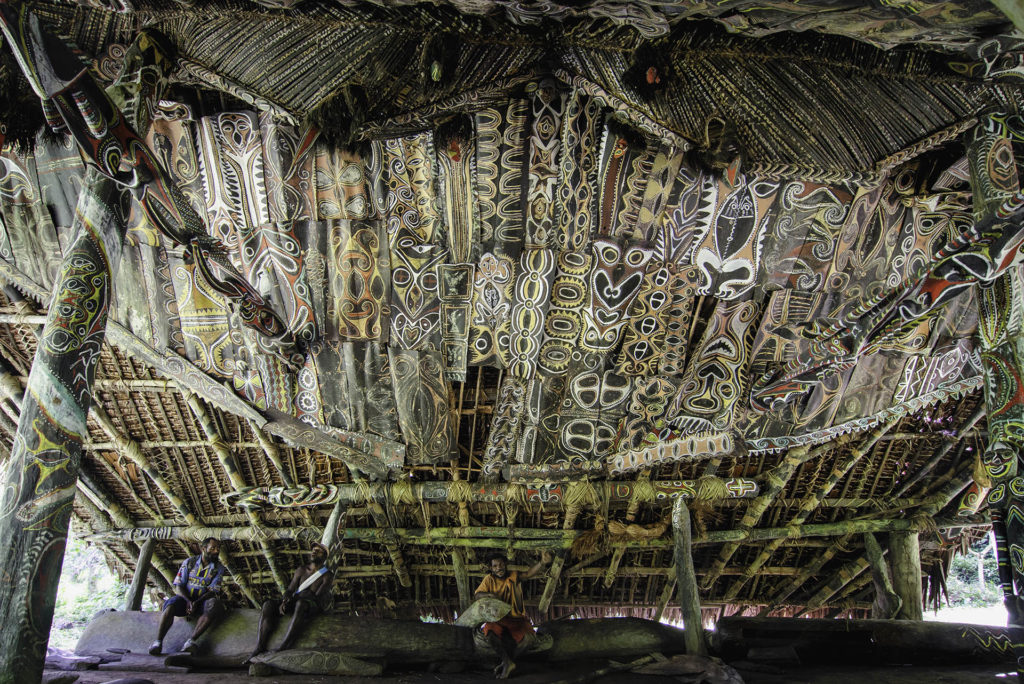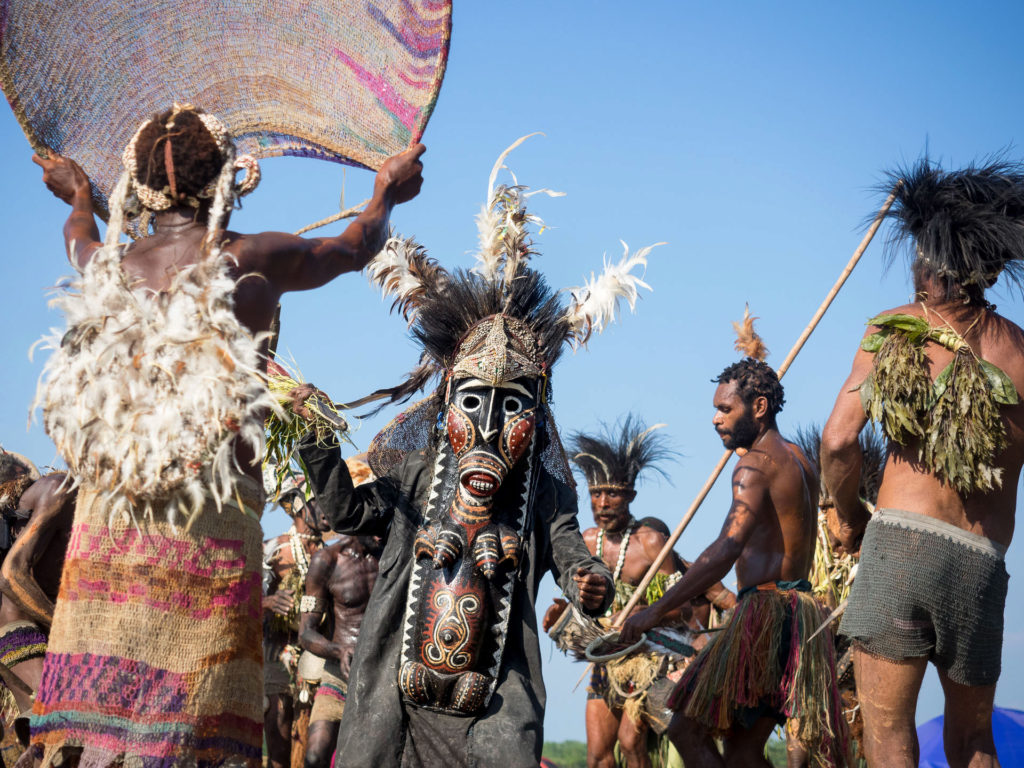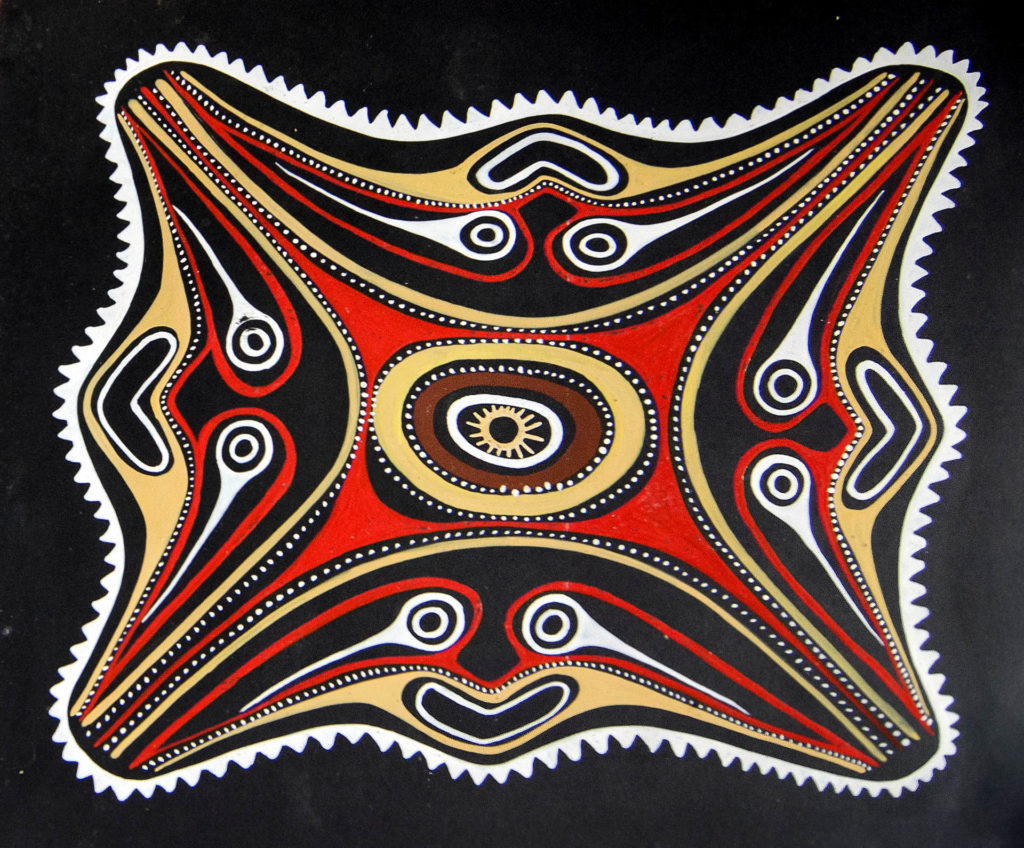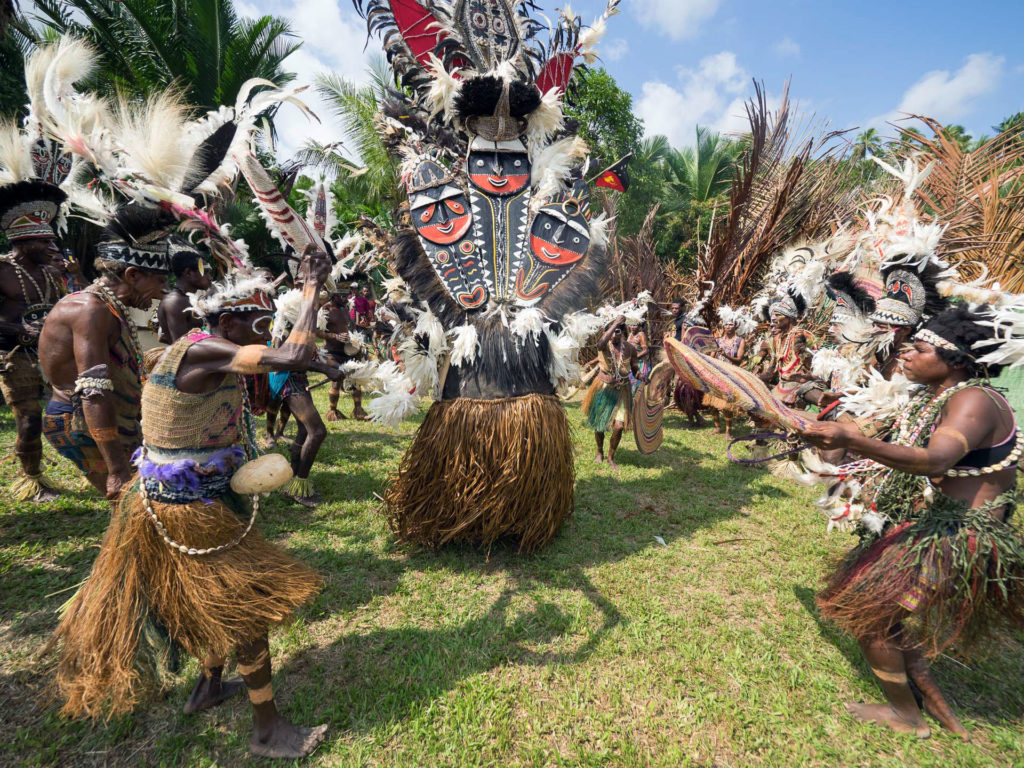
In 2012 I arrived in Pagwi, on the bank of Sepik River, on what was planned to be a three days trip. Just to have a look… I slept at the waterfront, and on the first morning, quite early, a lady offered to take me upstream, to Ambunti. I wasn’t sure what to do, I packed my stuff and jumped on her canoe.
I knew nothing about the Sepik people, as I was in PNG only to do a visa run from Indonesia.
In Ambunti, I was introduced to a local artist, Nanias, who told me he is a Kwoma man. OK. Chewing betel nuts, he was talking about powerful carvings, secret recipes for mud paint mixed with menstrual blood, spirits and monsters (masalai), sorcery, tribal wars, and other such things which made me sceptical. Then, he showed me a painting, the Spirit of Water, and told me that motif was secret. It belonged to his wife’s clan, from the Gala Tribe, but through the alliance, he was allowed to tell its’ story. I took a paper and wrote it down, and snapped some photos of his paintings. I ended up travelling two months, upstream, along the Sepik, dragged by its people.
In the following years, I kept returning to record myth stories and legends.
Between 2012 and 2018, I explored a few remote communities along the middle and upper Sepik course. I didn’t use a guide, not even a map. I found my way by word of mouth, through extended families, following their stories. My hosts adopted me as part of the family, and I moved at their pace. I joined them working sago, catching fish, hunting, trading crocodile skins and gold mining. I attended ritual ceremonies, watched village court trials for custom-breaking and sorcery, witnessed wife exchanges and listened to everyday issues mixing old taboos and nowadays solutions.
Several “big man” (community elders) and young artists were receptive to share their stories with me. I was fascinated that they still provide valid references for land ownership and inter-clan relationships even to the people updated with the Papua New Guinean citizenship status and church membership. And each place has a story, and each story has more people claiming to have its correct version and ownership over it.
I gathered over a hundred folk-tales, waiting now on my hard drive to be transcribed, and set free the Sepik monsters, heroes, wizards and spirits.
As I arrived on Sepik unprepared, and the Internet era was not there yet, I tried to find information on the way, to draw an itinerary. Unsurprisingly, I couldn’t find any decent map and no reliable estimations of travelling durations either. Not to say that I didn’t have a destination, the only references being the 60 days PNG visa and my very short money. Following my hosts and listening to their stories, we passed the territories of the Eagles, the Flying Foxes, the Gala warriors, the Yambun Gate where the crocodile masalai Pyoki lives, the bridge over the water of the masalai Haklamba, the forest where Holengri, a masalai who can transform into a cliff, protects the land, and so. The further I was going, a populated map, lìke the medieval ones, was unfolding. This was not a static nor a one plane map. And without the big picture perspective, and everything happening here and now, navigation was as trying to tell the future. I could choose, or think that I’ve chosen, to go in a direction, and end up back to the starting point, or who knows where. A recent inter-clan conflict, the rumour of a murder, a broken canoe engine, drought, a malaria episode or local superstitions could throw me in a different direction. The borders and the routes are tangled as the clans and their stories relate to each other, and all follow the slowly winding Sepik waters continuously changing their course.
After being Christianised, most of the Sepik River people left their ritual arts and ceremony houses, labelled as pagan and dangerous. It didn’t happen in the same way all along the Sepik course, and the difference seems to get accentuated with the arrival of tourists and “tribal art” collectors.
While on the lower and middle Sepik, the most developed and most visited area, quite a few communities preserved the tradition of haus tambaran (ceremony house) and singsing (ritual ceremony and storytelling), on the remote upper Sepik, these almost disappeared.
At Kwoma people (middle Sepik), there can be seen a revival of tambaran tradition. The people don’t seem to be motivated only to earn from tourists, who are scarce and unreliable, but also inspired by community pride.
There’s a lively dispute on how their myths should be presented, and who has the right to tell their stories. A clan has the “copyright” over its myths. Wokina and Kaipuk, two big-man from Tongujamb: if you brake the rule, you have to pay with a rooster or a pig! But keeping a story confined to its’ clan increases the probability to lose it forever.
As more people start to live outside clan boundaries, the communities are facing new challenges. People turn to public administration and private business to ask for financial support for their culture. They are also looking for art-work buyers, including parts of the old tambarans. Sacred motives, which used to be hidden for the uninitiated, are now used to decorate local markets and even Catholic churches.
In the remote villages from the upper Sepik, all tambarans were left in ruin, some were burned, exorcised, after the arrival of Cristian missionaries, staring with the 50s-70s. But, people there continue to live entirely from their forest and the river, like their ancestors did. The taboos and guidelines, transmitted through their stories, as well as witchcraft, sorcery and village courts, are part of everyday life there, to a greater extent than what I observed downstream.
The upper Sepik basin is on the UNESCO inclusion list. But now, hidden from the public eyes, oil palm plantations, pushed in by Chinese run businesses and allowed by a corrupted administration, threaten to wipe it out.

Translation and adaptation
“The white man has the story in the Bible. The story of everything is in their book. For us, it’s the tambaran. Thinking, only thinking. We don’t have any book. How our ancestors came on this ground, generation to generation, to generation. Everything is in our head.” Keli Kandi, an Abelam elder.
Around 200 languages and dialects, grouped in different linguistic families, are spoken in the Sepik Basin. This is the highest linguistic diversity in the world.
I recorded the stories in PNG Pidgin, the common language used among all ethnic groups. It’s a language without conjugations, declination, tenses, forms for the plural and singular or genders, and with a striking poor vocabulary. One must know details of context, to understand a story.
For example, he, she, it, and their declinations are all translated only by “em“. Long, tall, wide, to, from, at, of, toward, about, on, into, onto, through, are all, literally, all of them, translated only by “long“. Listening to a story was like watching a foreign-language movie with delayed subtitles, my understanding was dragging a few phrases behind the storyline.
An issue I struggle with is spelling the names. The indigenous didn’t know any alphabet. In many cases, It was the Christian missionaries, mostly the Protestants, who adapted the Latin alphabet to suit the writing for native languages, for translating the Bible. Many local stories and names have never been written. The communities spread and mixed, carrying their stories by word of mouth. A character’s name can sound different from one village to another, and the spelling is relative.
The people, besides the given name, use the names of their ancestors, as a reminder of their lineage. Someone can refer to himself (usually the storytellers are men) using different names. Additionally, in some communities is indicated the order of birth, and there can be different valid names for “The firstborn”.
In Waburu, a remote settlement on the upper Sepik, I asked an old man, who had told me a story, how to spell his name. It followed a few minutes of discussions with his younger friends, and I was told at least five or six names, as they were tracking back his ancestors. Finally, I chose the first one and wrote it as it seemed OK to me.
My storytellers heard the stories in their native language, told them to me in PNG Pidgin, and now I translate them into English. I try to stick close to the original, as I understood it. I try to do a direct translation, and I remove only the repetitions and dialogues which occurred during storytelling.
The stories are told, enacted and singed. The flow of my transcription can be improved, but that means to re-tell them. I tried to preserve somehow the feeling of listening to them first hand.
I’d appreciate feedback and suggestions regarding the adaptation of the text for general readers.
Before the end, I feel to write a kind of disclaimer too.
These fairy tales don’t sound like Disney ones. Most of them are myths from the tambaran, transmitted by the tribe’s elders for the initiated men. The people in the stories can kill people, eat people, have sex or act violently regardless of the issue. And these can be described explicitly, as their life is. Normal people kill normal people, without hiding under ogres or warlocks.
The ethic is biased. Fair, good and bad are relative, and often don’t represent a matter. A violent reaction doesn’t have to look appropriate on westerner’s terms. It is how it is. This doesn’t mean there are no laws and teachings in the stories. A leitmotif is sharing the food, and those who don’t comply with this law are punished very, very hard. But the stories don’t necessarily have a conclusion or a clear end.
A few times, I heard the same story from different people. I realized that the humour and the mood are not related to the story, they are infused into it by the storyteller. In such cases, I transcribe the one with a “good vibe”.
For more, read the stories.
Some words and expressions I found difficult to translate into English, and I avoided making explanations within the stories. I wrote a glossary with captioned photos, here, to describe them and give a little bit of context to Sepik folklore. It might be good to check it before reading the stories.



I just discovered your site and I am most interested in your project on several levels. Collections of the arts of the Asmat people made their way into South Florida in the 1990’s. A graduate in Art History, I have accumulated a small, but avid collection.
My own life’s work however, has been as Historian, author, instructor, family confidant to the clans of the Elaposhneechaathli people of Southern Florida… a very reticent 70% of the native population, (that most call “Seminoles!”). My family has been with the people for 130 years. This is my 50th year of research; University Press of FL is my publisher.
I have a major Iwam canoe prow, supposed from April River. Although is was listed as representing “an alligator”… It in no way resembles “those” very common prows (and being from S FL, I know alligators very well!!!).
Interestingly, the Metropolitan Museum in NYC has (an anonymous) in a donation to the Rockefeller colln. a very similar, tho simplistically stylized rendition of my prow. Those are the ONLY examples that I have seen while researching what I believe to be a depiction of a mythological, Aquatic Folk Creature!”
Locating your site, I see some hope of solving this conundrum and establishing this very special depicted beast with a history in folklore and “a name.”